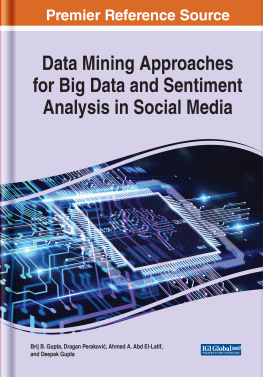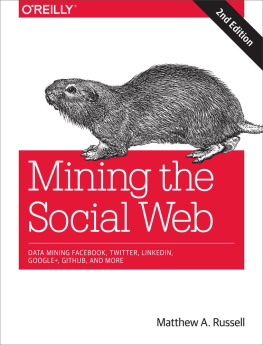Danneman Nathan - R mining spatial, text, web, and social media data: create and customize data mioning algorithms: a course in three modules
Here you can read online Danneman Nathan - R mining spatial, text, web, and social media data: create and customize data mioning algorithms: a course in three modules full text of the book (entire story) in english for free. Download pdf and epub, get meaning, cover and reviews about this ebook. City: Birmingham;UK, year: 2017, publisher: Packt Publishing, genre: Home and family. Description of the work, (preface) as well as reviews are available. Best literature library LitArk.com created for fans of good reading and offers a wide selection of genres:
Romance novel
Science fiction
Adventure
Detective
Science
History
Home and family
Prose
Art
Politics
Computer
Non-fiction
Religion
Business
Children
Humor
Choose a favorite category and find really read worthwhile books. Enjoy immersion in the world of imagination, feel the emotions of the characters or learn something new for yourself, make an fascinating discovery.
- Book:R mining spatial, text, web, and social media data: create and customize data mioning algorithms: a course in three modules
- Author:
- Publisher:Packt Publishing
- Genre:
- Year:2017
- City:Birmingham;UK
- Rating:5 / 5
- Favourites:Add to favourites
- Your mark:
R mining spatial, text, web, and social media data: create and customize data mioning algorithms: a course in three modules: summary, description and annotation
We offer to read an annotation, description, summary or preface (depends on what the author of the book "R mining spatial, text, web, and social media data: create and customize data mioning algorithms: a course in three modules" wrote himself). If you haven't found the necessary information about the book — write in the comments, we will try to find it.
Create data mining algorithms
About This Book
- Real-world case studies will take you from novice to intermediate to apply data mining techniques
- Deploy cutting-edge sentiment analysis techniques to real-world social media data using R
Who This Book Is For
This Learning Path is for R developers who are looking to making a career in data analysis or data mining. Those who come across data mining problems of different complexities from web, text, numerical, political, and social media domains will find all information in this single learning path.
What You Will Learn
- Discover how to manipulate data in R
- Get to know top classification algorithms written in R
- Explore solutions written in R based on R Hadoop projects
- Apply data management skills in handling large data sets
- Acquire knowledge about neural network...
Danneman Nathan: author's other books
Who wrote R mining spatial, text, web, and social media data: create and customize data mioning algorithms: a course in three modules? Find out the surname, the name of the author of the book and a list of all author's works by series.












